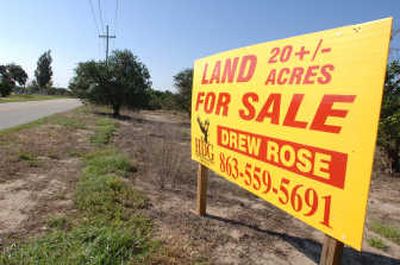Citrus squeeze

FORT PIERCE, Fla. – There seem to be more tractors tearing up St. Lucie County’s old citrus groves than tending them these days.
This county once had more orange and grapefruit trees than almost any other place in Florida, the nation’s largest citrus producer. Now it’s one of the fastest-growing counties in one of America’s fastest-growing states, and that land is fast giving way to housing tracts.
The same is happening in varying degrees across Florida’s citrus belt. It has been for years, but the slow slide has suddenly quickened. Farmers are replanting fewer trees than at any point since the 1970s, and crop land is rapidly disappearing. Previously high land prices, diseases like citrus canker and greening and even the rising cost of trees are hurting farmers and driving orange juice prices to record levels, up more than a third since 2002.
“It’s a very, very expensive process to get back into the business, even though you have land sitting there fallow,” said Doug Bournique, head of the Indian River Citrus League. “It’s not a dollar a tree like it was 20 years ago, just to pop them into the ground.” It can now cost $10 a tree.
Florida lost 127,182 acres (17 percent of its total) in the 2006 crop census – the second worst drop in history behind only a January 1986 freeze. The net loss was higher than the previous eight years combined.
The U.S. Department of Agriculture does not tie specific reasons to any acre lost, but growers and other industry officials say the problems are plain. Canker and greening forced the destruction of tens of thousands of acres of trees in the past decade, and bad hurricane seasons in 2004 and 2005 raked groves. Some farmers sold to developers when land prices skyrocketed the past few years, though recent slowing in the housing market probably stymied that trend.
The fundamental problem is that it keeps costing more to grow. Canker and greening bacteria have forced farmers into tedious and expensive procedures to decontaminate workers and find infected trees.
Canker, which makes fruit unusable, is spread by the wind and contaminated clothes and equipment. The disease has made three waves in Florida, the most recent starting in 1995. It quickly infected not only groves, but also nurseries, leaving replacement trees in scarce supply. Previously, any tree within 1,900 feet of one tested positive for canker had to be destroyed. The state abandoned that program after hurricanes spread the disease so far it couldn’t be contained.
Greening kills trees and is spread by an Asian insect accidentally brought to Florida. Neither disease harms humans.
To protect trees, citrus nurseries now grow in greenhouses, and many are relocating away from commercial citrus territory. The changes have sent tree prices soaring.
New stock won’t be available until spring 2009 for Leroy Smith Inc., said Trey Smith, vice president of marketing. He said some nurseries had trees available sooner, but it was much more expensive.
“I know some people that paid close to $10 for immediate delivery,” Smith said. “It’s a huge increase and it’s a greater risk. Your cost inputs have increased, but at the same time your risk is more with the situation with canker and greening.”
As a result, Bournique said, some farmers are leaving land unplanted. For example, only 58 acres of citrus was replanted in Indian River County in 2006 – by far the lowest in history. That figure was as high as 3,225 acres in 1992, and had never been under 200 acres.
“A lot of growers are sitting there with fallow land, but you don’t want to plant new trees. You’re looking at your friends and neighbors to see if there’s infected land next door,” Bournique said. “Tree costs have doubled. You’ve got to spray more and do a lot of different things to protect them. The gamble is bigger, the expense is bigger.”
Despite the trouble, officials in the $9 billion Florida citrus industry remain optimistic. Bournique likens it to 1980s freezes, from which the industry rebounded with increasing acreage that peaked in 1996.
“Men became millionaires,” Bournique said of growers who stayed through the tough times.
The potential difference is that replanting spiked after the freezes, and that hasn’t happened this time. It takes three years for a new tree to bear fruit.